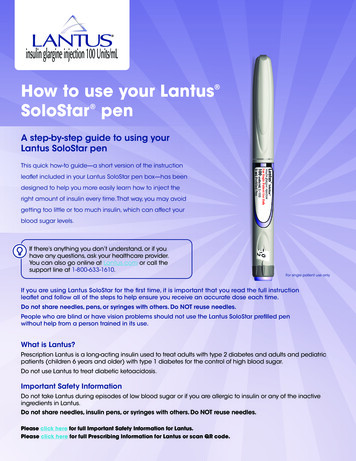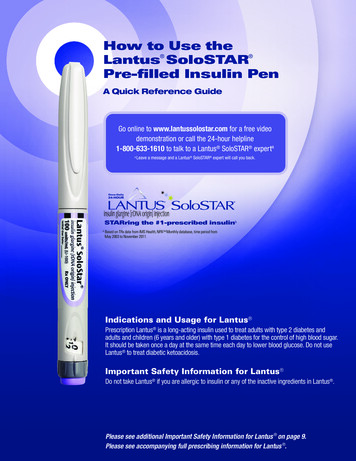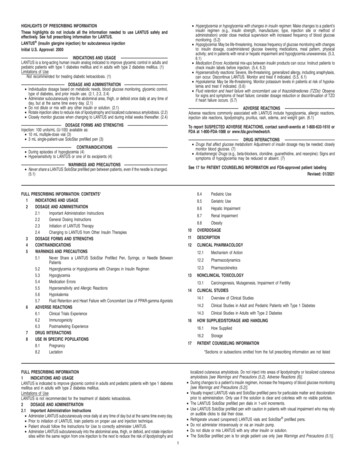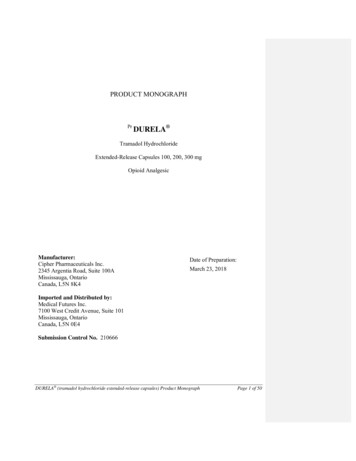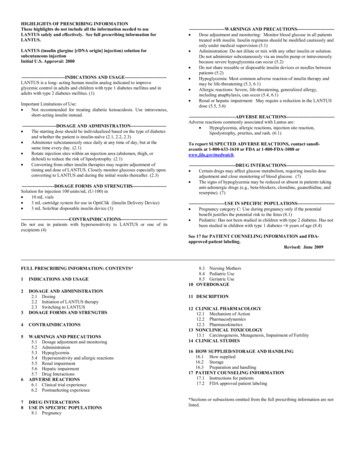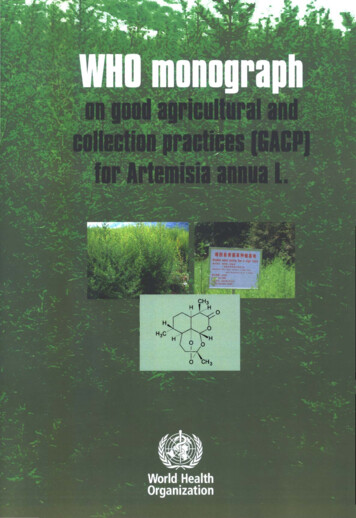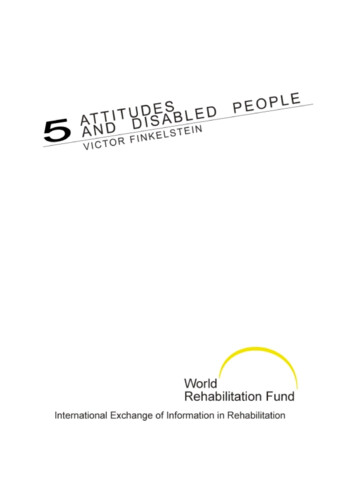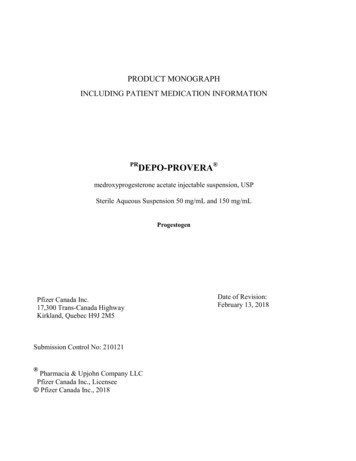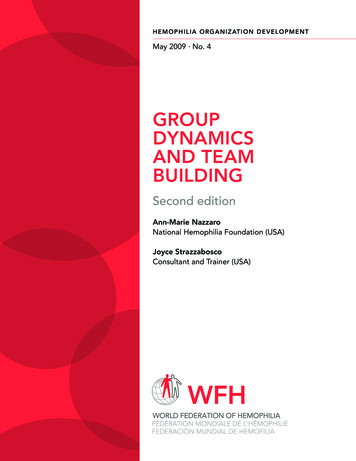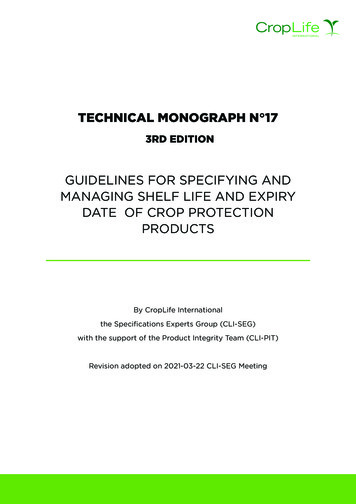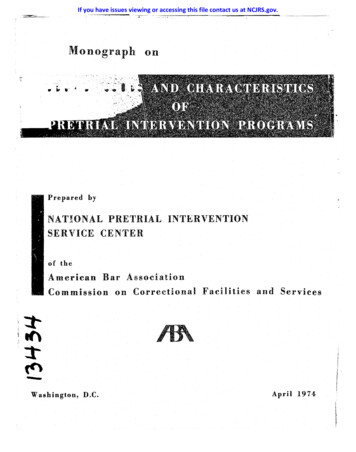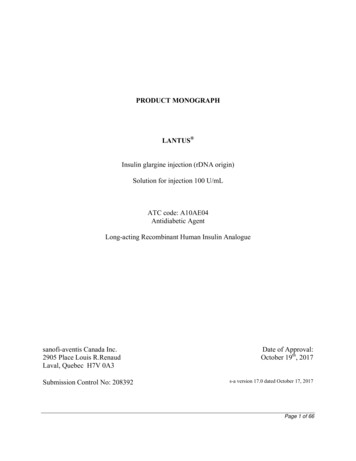
Transcription
PRODUCT MONOGRAPHLANTUS Insulin glargine injection (rDNA origin)Solution for injection 100 U/mLATC code: A10AE04Antidiabetic AgentLong-acting Recombinant Human Insulin Analoguesanofi-aventis Canada Inc.2905 Place Louis R.RenaudLaval, Quebec H7V 0A3Submission Control No: 208392Date of Approval:October 19th, 2017s-a version 17.0 dated October 17, 2017Page 1 of 66
Table of ContentsPART I: HEALTH PROFESSIONAL INFORMATION . 3SUMMARY PRODUCT INFORMATION . 3DESCRIPTION . 3INDICATIONS AND CLINICAL USE . 3CONTRAINDICATIONS . 4WARNINGS AND PRECAUTIONS. 4ADVERSE REACTIONS . 11DRUG INTERACTIONS . 17DOSAGE AND ADMINISTRATION . 18OVERDOSAGE . 21ACTION AND CLINICAL PHARMACOLOGY . 22STORAGE AND STABILITY. 26SPECIAL HANDLING INSTRUCTIONS . 27DOSAGE FORMS, COMPOSITION AND PACKAGING . 27PART II: SCIENTIFIC INFORMATION . 29PHARMACEUTICAL INFORMATION . 29CLINICAL TRIALS . 30DETAILED PHARMACOLOGY . 37TOXICOLOGY . 37REFERENCES . 40PART III: CONSUMER INFORMATION. 43PART III: CONSUMER INFORMATION. 51PART III: CONSUMER INFORMATION. 59Page 2 of 66
PRODUCT MONOGRAPHLANTUS insulin glargine injection (rDNA origin)Antidiabetic AgentLong-acting Recombinant Human Insulin AnaloguePART I: HEALTH PROFESSIONAL INFORMATIONSUMMARY PRODUCT INFORMATIONRoute ofAdministrationDosage Form /StrengthClinically Relevant NonmedicinalIngredientsSubcutaneousSolution for injection100 U/mLglycerol 85%, m-cresol, polysorbate 20(10 mL vial only), zinc, and water forinjection.Hydrochloric acid and sodium hydroxide forpH adjustment.DESCRIPTIONLANTUS [insulin glargine injection (rDNA origin)] is a recombinant human insulin analoguethat is a long-acting, parenteral blood-glucose-lowering agent. LANTUS is produced byrecombinant DNA technology utilizing a non-pathogenic laboratory strain of Escherichia coli(K12) as the production organism.Insulin glargine differs from natural human insulin in that the amino acid asparagine at position21 of the A-chain is replaced by glycine and two arginines are added to the C-terminus of the Bchain (see PHARMACEUTICAL INFORMATION, Drug Substance).INDICATIONS AND CLINICAL USELANTUS [insulin glargine injection (rDNA origin)] is a recombinant human insulin analogindicated for once-daily subcutaneous administration in the treatment of patients over 17 years ofage with Type 1 or Type 2 diabetes mellitus who require basal (long-acting) insulin for thecontrol of hyperglycemia.Page 3 of 66
LANTUS is also indicated in the treatment of pediatric patients ( 6 years old) with Type 1diabetes mellitus who require basal (long-acting) insulin for the control of hyperglycemia.CONTRAINDICATIONSLANTUS [insulin glargine injection (rDNA origin)] is contraindicated in patients who arehypersensitive to this drug or to any ingredient in the formulation or component of the container.For a complete listing, see DOSAGE FORMS, COMPOSITION AND PACKAGING.WARNINGS AND PRECAUTIONSSerious Warnings and PrecautionsHypoglycemia is the most common adverse effect of insulin, including LANTUS (seeWARNINGS AND PRECAUTIONS, Endocrine and Metabolism, Hypoglycemia). As with allinsulins, the timing of hypoglycemia may differ among various insulin formulations. Glucosemonitoring is recommended for all patients with diabetes.Uncorrected hypoglycemic or hyperglycemic reactions can cause loss of consciousness, coma, ordeath.Any change of insulin should be made cautiously and only under medical supervision.LANTUS is not intended for intravenous or intramuscular administration. The prolongedduration of activity of insulin glargine is dependent on injection into subcutaneous tissue.Intravenous administration of the usual subcutaneous dose could result in severe hypoglycemia.LANTUS must not be mixed with any other insulin or diluted with any other solution. IfLANTUS is diluted or mixed, the solution may become cloudy, and the pharmacokinetic/pharmacodynamic profile (e.g., onset of action, time to peak effect) of LANTUS and/or themixed insulin may be altered in an unpredictable manner (see DOSAGE ANDADMINISTRATION).This insulin product shall not be used if it is not water-clear and colourless or if it has formed adeposit of solid particles on the wall of the vial or cartridge (see DOSAGE ANDADMINISTRATION).GeneralAs with all insulin preparations, the time course of LANTUS action may vary in differentindividuals or at different times in the same individual and the rate of absorption is dependent onblood supply, temperature, and physical activity.Page 4 of 66
Hypokalemia is among the potential clinical adverse effect associated with the use of all insulintherapies, particularly when given intravenously. However, LANTUS should not be givenintravenously (see DOSAGE AND ADMINISTRATION, Administration). If left untreated,hypokalemia may cause respiratory paralysis, ventricular arrhythmia, and death. This potentialclinical adverse effect may be more relevant in patients who are at risk for hypokalemia (e.g.,patient using potassium lowering drugs), patients taking medications sensitive to serumpotassium concentrations, or patients losing potassium through other means (e.g. diarrhea).Stress or concomitant illness, especially infectious and febrile conditions may change insulinrequirements.Insulin may cause sodium retention and edema, particularly if previously poor metabolic controlis improved by intensified insulin therapy.Patients with human insulin antibodies may be hypersensitive to other insulins, with a risk ofhypoglycemia and/or cross-reactivity.Thiazolidinediones (TZDs), alone or in combination with other antidiabetic agents (includinginsulin), can cause heart failure and edema. The combination of TZD with insulin is notindicated for the treatment of Type 2 Diabetes Mellitus. Please refer to the respective TZDproduct monograph WARNINGS AND PRECAUTIONS information when the use of thesedrugs in combination with any insulin, including LANTUS, is contemplated.To avoid transmission of disease, cartridge or a prefilled syringe shall not be used by more thanone person.Accidental mix-ups between insulin glargine and other insulins, particularly short-actinginsulins, have been reported. To avoid medication errors between insulin glargine and otherinsulins, patients should be instructed to always check the insulin label before each injection (seeADVERSE REACTIONS).Endocrine and MetabolismHypoglycemia:As with all insulin preparations, hypoglycemic reactions, especially during initiation of therapy,may be associated with the administration of LANTUS. Hypoglycemia is the most commonadverse effect of insulins (see ADVERSE REACTIONS). Hypoglycemia may occur if theinsulin dose is too high in relation to the insulin requirement (see OVERDOSAGE). Earlywarning symptoms of hypoglycemia may be different, be less pronounced or absent undercertain conditions, as for example, in patients whose glycemic control is markedly improved, inelderly patients, in patients where an autonomic neuropathy is present, in patients whosehypoglycemia is developing gradually, in patients with a long history of diabetes, in patients withpsychiatric illness, or in patients receiving concurrent treatment with certain other drugs such asPage 5 of 66
beta-blockers. Hypoglycemia may occur with other substances including alcohol and psychiatricmedications, street drugs, birth control pills, injections and patches (see DRUGINTERACTIONS: Drug-Drug Interactions).Such situations may result in severe hypoglycemia (and possibly, loss of consciousness) prior topatients’ awareness of hypoglycemia.The time of occurrence of hypoglycemia depends on the action profile of the insulins used andmay, therefore, change when the treatment regimen or timing of administration is changed.As with all insulins, prolonged or severe hypoglycemic attacks, especially if recurrent, may leadto neurological damage, loss of consciousness, coma or death (see ADVERSE REACTIONS).As with all insulins, additional caution (including intensified blood glucose monitoring) shouldbe exercised in patient populations who are at greater risk for clinically significant sequelae fromhypoglycemic episodes.In a clinical study, symptoms of hypoglycemia or counter regulatory hormone responses weresimilar after intravenous insulin glargine and regular human insulin both in healthy subjects andadult patients with type 1 diabetes.Hypoglycemic reactions following treatment with insulin products such as LANTUS are mostlymild and easily managed. Changes in insulin therapy or changes in life style (i.e. diet, omissionof a meal, exercise/ physical activity) may require a change in dosage to avoid hypoglycemia.Glucose monitoring is recommended for all patients with diabetes.Diabetic patients should be instructed to carry a few lumps of sugar, candies or biscuits toprevent the progression of a hypoglycemic reaction, should one occur (see PART III:CONSUMER INFORMATION).Hyperglycemia:The use of too low insulin dosages or discontinuation of treatment, especially in Type 1 diabetes,may lead to hyperglycemia and diabetic ketoacidosis. Uncorrected hyperglycemic reactions cancause loss of consciousness, coma, or death.ImmuneInjection Site and Local Allergic Reactions:As with any insulin therapy, lipodystrophy may occur at the injection site and delay insulinabsorption. Other injection site reactions with insulin therapy include redness, pain, itching at theinjection site, hives, swelling, and inflammation. Continuous rotation of the injection site withina given area may help to reduce or prevent these reactions. Most minor reactions to insulinsPage 6 of 66
usually resolve in a few days to a few weeks. They may occur if the injection is not properlymade (irritants in the skin cleansing agent or poor injection technique), or if the patient is allergicto the insulin or any excipients.Rarely, SC administration of insulin products can result in lipoatrophy (depression in the skin) orlipohypertrophy (enlargement or thickening of tissue). Patients should be advised to consult theirdoctor if they notice any of these conditions.Reports of injection site pain were more frequent with LANTUS than NPH human insulin (2.7%insulin glargine versus 0.7% human NPH). The reports of pain at the injection site were usuallymild and did not result in discontinuation of therapy. Other possibly related treatment-emergentinjection site reactions occurred at similar incidences with both insulin glargine and NPH humaninsulin.Systemic allergic reactions:Immediate-type allergic reactions are rare. Such reactions to insulin (including insulin glargine)or the excipients may, for example, be associated with generalized skin reactions, angioedema,bronchospasm, hypotension, anaphylactic reaction or shock and may be life threatening (seeCONTRAINDICATIONS and ADVERSE REACTIONS).Antibody Production:Insulin administration may cause insulin antibodies to form. In clinical studies, antibodies thatcross-react with human insulin and insulin glargine were observed in both NPH human insulinand insulin glargine treatment groups with similar percents of increased and decreased titers.There was no correlation in either treatment group between increases or decreases in theseantibody titers and changes in either A1C or total insulin requirements. In theory, the presence ofsuch insulin antibodies may necessitate adjustment of the insulin dose in order to correct atendency to hyperglycemia or hypoglycemia, but has not been found on review of LANTUSclinical trials and available post-marketing data.Intercurrent conditions:Insulin requirements may be altered during intercurrent conditions such as infection or illness,emotional disturbances, or stress.Renal / Hepatic / Biliary / Pancreatic impairmentAlthough studies have not been performed in patients with diabetes and hepatic or renalimpairment, LANTUS requirements may be diminished due to reduced capacity forgluconeogenesis and reduced insulin metabolism (see ACTION AND CLINICALPHARMACOLOGY, Special Populations and Conditions). Careful glucose monitoring and dosePage 7 of 66
adjustments of insulin or insulin analogues including LANTUS may be necessary in patientswith hepatic or renal dysfunction.Page 8 of 66
RetinopathyA marked change in glycemic control may cause temporary visual impairment, due to temporaryalteration in the turgidity and refractive index of the lens.Long-term improved glycemic control decreases the risk of progression of diabetic retinopathy.However, as for all insulin regimens, intensification of insulin therapy with abrupt improvementin glycemic control may be associated with temporary worsening of diabetic retinopathy.In patients with proliferative retinopathy, particularly if not treated with photocoagulation, severehypoglycemic episodes may result in transient amaurosis (see ADVERSE REACTIONS, Eyedisorders).Transferring Patients from Other InsulinsAny change of insulin should be made cautiously and only under medical supervision. Changesin insulin strength, timing of administration, manufacturer, type (e.g., regular, NPH, or insulinanalogs), species (animal, human), or method of manufacture (recombinant DNA versus animalsource insulin) may result in the need for a change in dosage. Concomitant oral antidiabetictreatment may need to be adjusted. As with all insulins, when transferring to LANTUS, the earlywarning symptoms of hypoglycemia may be changed, be less pronounced, or absent. Theprolonged effect of subcutaneous LANTUS may delay recovery from hypoglycemia (seeDOSAGE AND ADMINISTRATION).Special PopulationsPregnant Women:Teratogenic effectsFor insulin glargine no clinical data on exposed pregnancies from controlled clinical studies areavailable. Post Marketing data on pregnant women (more than 1000 pregnancy outcomes)indicate no reports of specific adverse effects of insulin glargine on maternal and fetal/neonataloutcomes.Animal data do not indicate reproductive toxicity (see Part II: TOXICOLOGY, ReproductionToxicity and Impairment of Fertility).It is essential for patients with diabetes or a history of gestational diabetes to maintain goodmetabolic control throughout pregnancy to prevent adverse outcomes associated withhyperglycemia.Page 9 of 66
Insulin requirements may decrease during the first trimester and generally increase during thesecond and third trimesters. Immediately after delivery, insulin requirements decline rapidly(increased risk of hypoglycemia). Careful monitoring of glucose control is essential.Patients with diabetes should be advised to inform their doctor if they are pregnant or arecontemplating pregnancy.Nursing Women:It is unknown whether insulin glargine is excreted in significant amounts in human milk. Manydrugs, including human insulin, are excreted in human milk. There are no adequate and wellcontrolled studies in nursing women. For this reason, caution should be exercised whenLANTUS is administered to a nursing woman. Lactating women may require adjustments ininsulin dose and diet.Pediatrics ( 6 years of age):Safety and effectiveness of LANTUS has been established in children over 6 years of age withType 1 diabetes mellitus (see ACTIONS AND CLINICAL PHARMACOLOGY, SpecialPopulations and Conditions, and INDICATIONS AND CLINICAL USE).Geriatrics ( 65 years of age):In controlled clinical studies comparing insulin glargine to NPH human insulin, 593 of3890 patients with type 1 and type 2 diabetes were 65 years and older. The only difference insafety or effectiveness in this subpopulation compared to the entire study population was anexpected higher incidence of cardiovascular events in both insulin glargine and NPH humaninsulin treated patients.In elderly patients with diabetes, the initial dosing, dose increments, and maintenance dosageshould be conservative to avoid hypoglycemic reactions.Hypoglycemia may be difficult to recognize in the elderly (see WARNINGS ANDPRECAUTIONS, Endocrine and Metabolism, Hypoglycemia). In the elderly, progressivedeterioration of renal function may lead to steady decrease in insulin requirements. Carefulglucose monitoring and dose adjustments of insulin or insulin analogues including LANTUSmay be necessary (see WARNINGS AND PRECAUTIONS, Renal/ Hepatic/ Biliary/ Pancreaticimpairment).Other:The presence of diseases such as Acromegaly, Cushing's Syndrome, Hyperthyroidism, andPheochromocytoma can complicate the control of Diabetes Mellitus.Page 10 of 66
Pens to be used with LANTUS cartridgeThe LANTUS cartridge should only be used with the following pens: JuniorSTAR , which delivers LANTUS in 0.5 unit dose increments. ClikSTAR which delivers LANTUS in 1 unit dose increments. AllStar Pro which delivers LANTUS in 1 unit dose incrementsThis cartridge should not be used with any other reusable pen as the dosing accuracy has onlybeen established with the listed pens.Occupational HazardsThe patient’s ability to concentrate and react may be impaired as a result of hypoglycemia orhyperglycemia or, for example, as a result of visual impairment. This may constitute a risk insituations where these abilities are of special importance (e.g. driving a car or operatingmachinery).Patients should be advised to take precautions to avoid hypoglycemia whilst driving. This isparticularly important in those who have reduced or absent awareness of the warning symptomsof hypoglycemia or have frequent episodes of hypoglycemia. It should be considered whether itis advisable to drive or operate machinery in these circumstances.ADVERSE REACTIONSAdverse Drug Reaction OverviewType 1 and type 2 diabetes in adults:The adverse events most commonly associated with LANTUS [insulin glargine injection (rDNAorigin)] include the following:Eyes disordersRetinopathy was evaluated in the clinical studies by means of retinal adverse events reported andfundus photography. The numbers of retinal adverse events reported for LANTUS and humanNPH treatment groups were similar for patients with type 1 and type 2 diab
LANTUS [insulin glargine injection (rDNA origin)] is a recombinant human insulin analogue that is a long-acting, parenteral blood-glucose-lowering agent. LANTUS is produced by recombinant DNA technology utilizing a non-pathogenic laboratory strain of Escherichia coli (K12) as the production organism.
